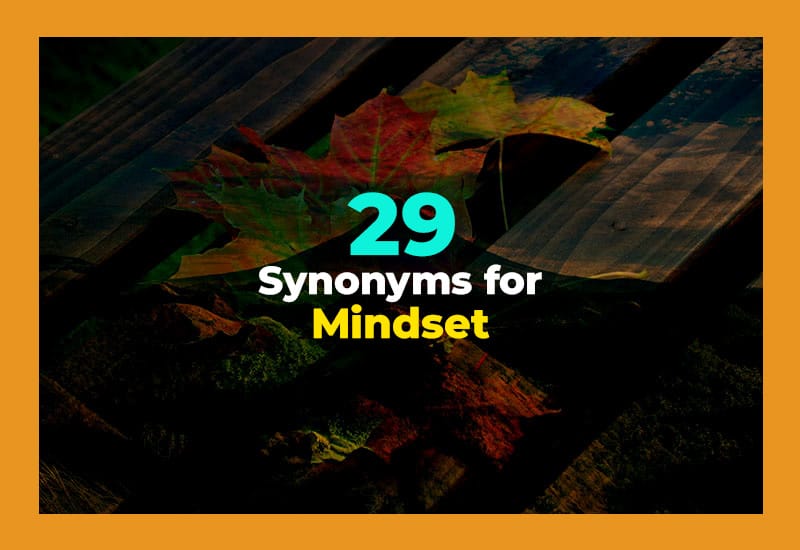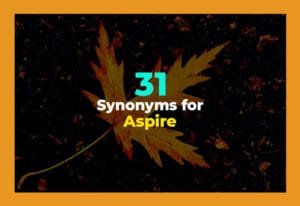You know how sometimes you’re just stuck in your own head, and someone says something that totally shifts your perspective? That's the magic of mindset—your mental approach to everything. But guess what? There are plenty of other words for it that can totally freshen up how you think, speak, and even write! From "attitude" to "mentality" to "worldview," each one adds its own unique flavor.
1. Attitude
Attitude is the way you feel or think about something, which then affects how you behave. It's basically your inner weather system. If you have a positive attitude, you'll often see things in a better light. For example, "Her attitude toward learning made the class so much more enjoyable." Or, "You need to change your attitude if you want things to improve." Your attitude can be shaped by experience, personality, or even your morning coffee! It’s not about pretending everything is perfect but choosing how you respond when it's not.
2. Mentality
Mentality refers to your general way of thinking, especially in terms of how you deal with situations. It's like your brain's default setting. For example, "He has a winner's mentality and never gives up." Or, "That kind of negativity shows a scarcity mentality." Whether you're approaching challenges with a strong mentality or letting fear take over, this mindset shapes your behavior big time. It’s not set in stone—you can totally train your mentality to be more positive and resilient with practice and intention.
3. Outlook
Outlook is your view or expectation of the future. It's about how you see what's coming, whether it's with hope or worry. "She has an optimistic outlook on life." Or, "His career outlook is very promising." Your outlook can change depending on what's happening in your life, but it usually says a lot about your general mindset. People with a positive outlook tend to bounce back quicker and see opportunities where others see roadblocks. It's like having mental sunglasses—your tint affects how you see the world.
4. Perspective
Perspective is how you view things, shaped by your experiences, feelings, and thoughts. Think of it like standing in a certain spot to see a painting—it changes everything. "From his perspective, things looked unfair." Or, "A change in perspective helped her solve the problem." Perspective is super powerful. It can calm you down, help you empathize, or make you think differently. Sometimes just stepping back or asking someone else how they see something can totally shift your mindset.
5. Approach
Approach means the way you handle a task, situation, or problem. It's like your strategy or plan of attack. "Her approach to solving problems is very creative." Or, "Try a different approach next time." Your approach reflects your mindset—if you’re open-minded, your approach might be more flexible. If you're set in your ways, you may resist new ideas. By changing your approach, you can often change your results. It's all about how you mentally gear up for what's ahead.
6. Disposition
Disposition is your natural attitude or usual mood. It's the emotional tone you carry around. "She has a cheerful disposition." Or, "His calm disposition helps in stressful situations." It's more about how you tend to feel day-to-day rather than what you do. But this definitely affects your mindset. Someone with a peaceful disposition might have a more relaxed way of seeing the world. While not always easy to change, being aware of your disposition can help you adjust how you think and respond.
7. Viewpoint
Viewpoint is the way you see or think about a specific topic or issue. It's your angle, your take. "From her viewpoint, the decision was unfair." Or, "Let's consider everyone's viewpoint before choosing." Viewpoint plays a major role in how we relate to others. Different viewpoints can lead to conflicts—or better understanding. Changing your mindset sometimes just means considering a different viewpoint. It helps you become more flexible and less stuck in your own head.
8. Frame of mind
Frame of mind means your mood or mental state at a certain moment. It's temporary but powerful. "I'm not in the right frame of mind to make that decision." Or, "She was in a happy frame of mind after getting the good news." This is one of those mindset synonyms that shows how mental states can shift quickly. Knowing your current frame of mind can help you make smarter choices or decide when to pause. It's like checking your emotional weather before making moves.
9. Philosophy
Philosophy, in this context, means your beliefs or system of thought that guide how you live. "His life philosophy is to always stay curious." Or, "My work philosophy is to always do my best." Your personal philosophy acts like a compass for your mindset. It helps you decide what matters and how to act in tough situations. People with strong philosophies often stay consistent, even when things get tough. It's not about being rigid—it's about knowing your values.
10. Belief system
Belief system is the collection of beliefs that guide how you think and behave. It's deeper than a single opinion—it's the whole structure. "Her belief system helped her stay strong during hard times." Or, "Different belief systems lead to different reactions." Your belief system shapes your mindset in a big way. If you believe people are good, you'll approach the world differently than if you don't. The cool part? You can challenge and change your belief system when it no longer helps you.
11. Thinking
Thinking is simply the process of using your brain to understand, decide, or imagine things. But it also reflects your mindset. "Positive thinking helps reduce stress." Or, "His thinking is very analytical." How you think affects what you do. If you're always thinking worst-case scenarios, your mindset will lean toward fear. If you think creatively, your mindset becomes more open. The good news? You can learn to control and shape your thinking to help you grow.
12. Stance
Stance is your position or opinion on an issue, often based on your mindset. "He took a firm stance against bullying." Or, "Her stance on health is very proactive." Your stance shows what you believe and how you plan to act. It's not just opinion—it's backed by your values and mindset. Sometimes, reevaluating your stance on something can reveal how your mindset has grown or changed. It's like checking your own progress on your internal map.
13. Way of thinking
Way of thinking is just how your brain tends to process stuff—your mental habits and patterns. "Her way of thinking is very optimistic." Or, "We need to change our way of thinking about failure." This one really connects to mindset because it's all about patterns. It's not what you think, but how you think it. And since habits can change, so can your way of thinking. It's all about noticing the patterns and choosing better ones.
14. Orientation
Orientation refers to the direction or focus of your thoughts, often in relation to goals or values. "He has a strong success orientation." Or, "Her orientation is more people-focused than task-focused." This mindset synonym highlights what you're tuned into mentally. Whether you're goal-oriented, service-oriented, or growth-oriented, your mindset reflects that. It's like the compass inside your head, pointing you toward what matters most to you.
15. Ideology
Ideology is a structured set of beliefs or ideas, especially about politics, culture, or life in general. "Her ideology centers around equality and fairness." Or, "They follow a conservative ideology." Ideologies help shape your mindset by giving you a mental framework to interpret the world. Sometimes ideologies can be too rigid, so it's smart to stay open and flexible. But having a basic ideology gives you a sense of direction and identity in how you think.
16. Thought process
Thought process is how your mind works through information, decisions, or problems. "His thought process is very logical." Or, "What's your thought process behind that choice?" Understanding your thought process is key to building a better mindset. Are you fast and reactive or slow and thoughtful? Do you consider different outcomes or jump to conclusions? Noticing these things can help you shift your mindset to be more balanced and effective.
17. Outlook on life
Outlook on life is your general attitude toward the world and your future. "He has a hopeful outlook on life." Or, "Her outlook on life changed after traveling." It's basically mindset zoomed out. It affects how you see people, challenges, and even yourself. When you work on having a healthier outlook on life, you naturally feel better and make better choices. It's all about choosing the lens you look through every day.
18. Habit of mind
Habit of mind means your regular way of thinking or responding to situations. "Curiosity is a helpful habit of mind." Or, "We should teach kids strong habits of mind." These habits make up your mindset and influence everything from how you learn to how you react under stress. You can build better habits of mind by practicing reflection, asking good questions, and staying open to feedback. The more you practice, the stronger your mindset becomes.
19. Point of view
Point of view is the way you interpret a situation, shaped by your experiences and beliefs. "From my point of view, that's a fair deal." Or, "Try to see it from their point of view." Your point of view colors everything you say and do. It's not right or wrong—it's just your version. But understanding others’ points of view can expand your mindset and make you more compassionate and smart in dealing with people.
20. Cognitive stance
Cognitive stance is your mental position or belief on a specific topic, often in how you process information. "His cognitive stance is based on evidence." Or, "She shifted her cognitive stance after learning more." This is a fancier way of saying how your brain is set up to think about something. It shows the angle you're coming from and whether you’re open or fixed in your thinking. Adjusting your cognitive stance can change how you learn and relate to new ideas.
21. Reasoning style
Reasoning style is how you make sense of things—whether through logic, emotion, intuition, or facts. "Her reasoning style is mostly intuitive." Or, "We all have different reasoning styles." This part of mindset shapes how you solve problems or make decisions. Some people are super analytical, others follow their gut. There's no best way—just different styles. But being aware of your own helps you make smarter choices and work better with others who think differently.
22. Temperament
Temperament is your natural personality, especially how you react emotionally. "He has a calm temperament, even under pressure." Or, "Her fiery temperament makes her passionate." It's not your full mindset, but it influences it. Someone with a relaxed temperament might have an easier time with stress, while a more intense person may need tools to manage their mindset. It's not about changing who you are, just working with it smartly.
23. Assumptions
Assumptions are things you believe to be true without proof, and they often shape your mindset. "She made assumptions about his skills that weren't fair." Or, "Check your assumptions before reacting." We all have assumptions. But when we start questioning them, our mindset starts to grow. That's how you move from being stuck to being curious. Assumptions aren't always bad—but they should be tested often.
24. Set of beliefs
Set of beliefs is the collection of things you think are true and important. "His set of beliefs influences every decision he makes." Or, "We all have different sets of beliefs." These beliefs are the building blocks of your mindset. If your beliefs are helpful, your mindset will reflect that. But if they're limiting, they'll hold you back. The great thing? Beliefs can be updated just like apps!
25. Emotional posture
Emotional posture is the emotional stance or energy you bring into situations. "Her emotional posture was calm and open." Or, "He had a defensive emotional posture." This reflects your emotional mindset and can affect how people respond to you. Changing your emotional posture—by relaxing, staying positive, or being open—can totally shift how others see and treat you.
26. Intellectual position
Intellectual position is your educated stance on a topic, shaped by knowledge and logic. "Her intellectual position was well thought out." Or, "We respect each other's intellectual positions." This shows a more academic or analytical mindset. It’s how you frame your ideas based on thought and learning, not just gut feeling.
27. Bias
Bias is a mindset shortcut—your tendency to lean one way, sometimes unfairly. "We all have unconscious biases." Or, "Try to notice your bias before making a choice." Bias isn’t always bad, but being unaware of it can hurt decision-making and relationships. Recognizing bias is the first step to improving your mindset.
28. Inclination
Inclination is your natural leaning toward something—your tendency. "She has an inclination to overthink." Or, "He's inclined to stay calm in conflict." Your inclination shows up in how you handle things and what mindset you default to. But you can shift your inclinations with effort and awareness.
29. Schema
Schema is your brain's system for organizing knowledge and experiences. "Her schema about success helped her stay focused." Or, "We all have schemas that shape how we react." These mental structures help you make sense of the world. But they can also limit you if they're outdated or inaccurate. Updating your schema can transform your mindset and open you up to new possibilities.

Final Thoughts
Exploring different synonyms for "mindset" gives us a better understanding of how complex our thoughts really are. Whether it's your attitude, perspective, or belief system, each term offers a unique way to talk about how we think. The cool part? Mindset isn't fixed. You can shape it, strengthen it, and even completely shift it with time and effort. By learning new ways to understand your thinking, you give yourself more power to grow. So keep learning, keep questioning, and always stay curious about your own mind.









